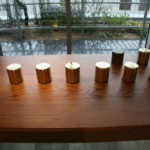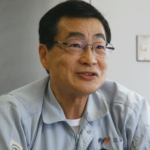Okawa Screw Manufacturing Co. has a business philosophy for the future that bears a strikingly Mexican name — “Gran Familia.” Katayama Osamu profiles the “grand family.”

Okawa Naoki, president of Okawa Screw Manufacturing Co.
KATAYAMA OSAMU PHOTO
Okawa Screw Manufacturing Co. was founded in 1934. It started as a small screw-processing factory run by an individual manager and dealt in small parts, including television switch bearings.
After commencing a business relationship with Nissan Motor Corp., the company began dealing in car parts.
In 1964, Okawa Screw Manufacturing took a significant leap forward by introducing the Parts Former specialized cold forming technology machine.
President Okawa Naoki says, “Our company introduced the Parts Former for the first time in Japan. My grandfather, the second-generation president of the company, made the decision to do so. He suddenly purchased a machine that cost ten times as much as his company’s monthly turnover at that time, almost as much as its annual turnover, although he did not have any business prospects. It was a major risk, but it constitutes the core technology of what is now Okawa Screw Manufacturing Co.”
Cold forming using the Parts Former enabled the company to mass-produce parts that had previously been manufactured by cutting. This led the company to take a significant leap forward. In addition, the manufacturer also accumulated cold forming technology and expertise in it and learned to produce more complex-shaped parts by cold forming.
Mexican Adventure
One of the problems that small and medium-sized enterprises often face is how to secure successors. Fortunately, Okawa Screw Manufacturing was free from such anxiety. In January 2018, Okawa Naoki, the fourth-generation president, the great-grandson of the corporate founder, took over the family business at the age of 38.
President Okawa says, “My grandfather, who introduced the Parts Former as the second-generation president, was an offensive type of manager. Katsuyoshi, my father, who was the third-generation president, conducted firmly defensive management in an era where defense was an important factor. But it is now time to return to an offensive approach, and I was asked to assume the presidency.”
After graduating from university, Okawa Naoki did not take over the family business, but joined Dentsu Inc., a leading advertising agency. He says, “Okawa Screw Manufacturing sells tangible values. But I wanted to experience a job selling intangible values. In the marketing division, I learned how to display things, how to communicate ideas and how to make presentations.”
In 2010, nine years later, he left Dentsu Inc. and joined Okawa Screw Manufacturing. A turning point came two years later. He traveled to Mexico by himself to establish a local factory.

Brake hose end fittings, the main product group of Okawa Screw Manufacturing since 1966. The company supplies the products to automobile manufacturers around the world.
COURTESY OF OKAWA SCREW MANUFACTURING
It was Okawa Naoki himself who had expressed the idea of making inroads into the Mexican market. For Okawa Screw Manufacturing to grow, it was essential to have dealings with Western car manufacturers, and it was necessary to establish a factory in North America to achieve this. Other company members, including the president, opposed his idea, but he overrode the opposition.
Okawa looks back on that time and says that he cannot describe his hard work in one word. He founded OKAWA MEXICANA, S.A. de C.V., a local company, and launched full-scale production in 2014.
It was immediately after the start of full-scale production that Okawa had the hardest time as the president of a local company. The first problem he faced was that he failed to secure the same level of quality assurance that he had pursued at the Japanese factories. He had to start by making local employees understand the fundamental basics of what quality was.
Okawa says, “We established in-house standards to assure the higher quality that customers demand. Probably because of cultural differences, however, the local employees ignored the Japanese quality standards and adopted a different style. We could issue instructions about machine operation using manuals, but we had a lot of difficulty instructing them about how important quality was at the level of awareness. We had a very hard time until we were able to adjust the standards of judgment about whether products were all right or not with Japan.”
To train the Mexican employees, the company sent them to Japan for half a year to a year and conducted training programs. By having them live in Japan and work with Japanese employees, the company taught them the attitude toward work, the ideas behind manufacturing and the importance of quality.
The company’s efforts were sufficiently effective to get the Mexican factory of OKAWA MEXICANA to a point where it was able to produce a new product in 2016. This new product was airbag inflator parts. These parts are extremely difficult to make because they require employees to manage the flow of steel components called fiber flow as well as the strength of metals.
In addition, Okawa Screw Manufacturing was also highly rated for its business performance in its flagship brake hose end fittings, and it received an increasing number of orders from Western countries. In the Japanese automobile industry, where there are many affiliated suppliers due to vertical integration, the company established a position as an independent Tier2.
Family-style Management

Okawa Screw Manufacturing prides itself on the quality of its human resources development. The machine in the background is for cold forming, a technology the company introduced to Japan in 1964 before any other company and in which it has accumulated world-leading technical know-how.
COURTESY OF OKAWA SCREW MANUFACTURING
Through his experience in Mexico, Okawa developed his own original management style. The experience made him think hard about what management was.
Okawa says, “If you ask me what I did in Mexico for five years, I will answer that I focused on having discussions with the employees.”
According to Okawa, in Mexico, the relationships between the company and its employees were wet, not dry like they are in the United States. He presented the concept of the “gran familia company” as a corporate philosophy. This concept is similar to the family business.
Okawa says, “Mexicans love family as the Japanese used to in the past. Based on this fact, I thought it would be a good idea to make my company a family. I thought about making my company a company that was aiming to be a ‘gran familia,’ a grand family. In the past, Japanese small and medium-sized enterprises took it for granted that they conducted family-style management. Even today, small and medium-sized enterprises retain very close relationships with their employees. I think that employees expect warm-heartedness like a grand family from their companies. Employees spend most of their time at their company, from the morning to the evening.”
The Mexican employees understood and accepted this concept.
Okawa says, “I think that they got the message. The total unemployment rate at Mexican industrial housing complexes was almost 10%. But in the case of OKAWA MEXICANA, it was just 1% to 2%.”
In summer, Okawa invited a circus to the backyard of the factory and invited the employees and their families to a party. At Christmas time, he held a Christmas party in the office. On these occasions, he enjoyed having some drinks with his employees and having conversations with them.
More than anything else, Okawa tried to talk to his employees every day.
Okawa says, “I think that in communicating with employees, you should keep in mind the importance of listening to them. You should also accept their requests for consultations. For example, you should think about their career visions together with them. More specifically, you should draw up a direction and a career vision for half a year ahead and offer mid-term advice as to what the employees should do for now. In this sense, it was exactly the same as in Japan.”
Okawa introduced a new idea for revitalizing in-house communications: the “Thank-You Coin.” He invented in-house coins that could be exchanged for a bottle of juice at a vending machine, and distributed them to the employees. It is a system of employees giving coins to their coworkers with the messages “Thank you” and “Good work” when they have been helped, taken care of or encouraged their coworkers. This idea was unique to Okawa, who developed marketing skills at Dentsu Inc.
In addition, one of the factors in the success of OKAWA MEXICANA is that Okawa entrusted the local employees with the operations. Immediately after the corporate registration, he said to the Mexican employees, “This company is yours.” This led them to develop self-reliance. Now, five years after the launch of the local factory, there are 108 employees at the Mexican factory, and both the factory manager and the personnel affairs manager are local Mexicans.
Okawa says, “After 2017, when I returned to the head office, I shuttled between Mexico and Tokyo at two-week intervals. But I found it so difficult to travel to Mexico every month after I had taken on the presidency of the head office that I now listen to reports and requests for consultations via video conferences with the local staff once a week.”
Maximum Quality Control
In recent years, we have seen frequent occurrences of scandals related to the quality of large corporations that symbolize the degradation of Japanese manufacturing.
Okawa, who believes that the last citadel that supports high-level quality assurance is the quality examination, braces himself for such news about scandals related to large corporations.
Okawa says, “We have produced brake hose end fittings for fifty years and have assured their quality. We have had no complaints from the markets. We make efforts for improvement to maintain quality every day. We examine all the parts we produce by machine. We develop those examination machines ourselves and accumulate expertise. In addition, we also examine every product with our own eyes.”
Okawa Screw Manufacturing produces 20 million units of brake hose end fittings each month. They examine every single part to secure quality. Because they are important automobile safety parts, they are required to control quality at the one-hundredth level. In order to avoid even minor errors, they utilize numerous examination methods, such as machines for physically measuring the depth of grooves, lasers and image processing by taking photos.
In addition, they conduct strict visual examinations of aspects that do not have a direct impact on safety, including color irregularities. If they find parts whose colors are slightly different, they remove them in a thorough effort to ensure quality.
The immediate issue facing Okawa Screw Manufacturing is how to adjust its factory to the Internet of Things (IoT).
Okawa says, “The important aspect of IoT is the visualization of data. We visualize information that exists everywhere in the factory. For example, we started by setting sensors on our machines to check their operation rates and entering data of operational contents, shifting from a hand-written style. We aim to continue undertaking improvement campaigns by providing real-time feedback on the information obtained from those data to the operators.”
Okawa Screw Manufacturing also makes efforts to introduce IT-based in-house systems, including personnel evaluations, as well as factories.
Of course, it is difficult to visualize and automate everything in the factory systematically. Okawa points out that they still depend on workmen for their experience and skills.
For example, they adjust minor distortions caused by machine using human hands in the process of cold forming using a metal mold. When steel is cut, it is divided into a fracture and a section. Experienced workmen can tell what adjustments they need to make to a particular machine by looking at the shapes of each cross-section and the subtle changes in color. They can spot a mechanical failure from a minor abnormality and undertake proper maintenance on it. They can correct minor differences and secure quality assurance before product precision is affected. It is said that a workman takes ten years to become a full-fledged workman.
Okawa says, “Ideally speaking, we should visualize parts in a way that enables anyone to work and organize the operational order. In fact, however, it is still difficult. There are areas that robots cannot handle.
Okawa says the following, arguing that they should aim for the direction of solving the contradictory goals of promoting IoT and breaking away from excessive poor systems.
“The standards of quality assurance, including ISO, can assure quality, but they also have a harmful effect. They cause employees to stop thinking. Employees fall into the bad habit of acquiring standards for themselves, which causes them to depend on a system and stop thinking for themselves. They are just relieved to be filling in a prepared frame, and cease looking at premises with doubt. I think that after all, the Japanese manufacturing industry lost the ability to think for itself during the lost decades. You should not neglect to think for yourself by depending fully on a system.”
Okawa says that his dream is to make his company continue to be a company where employees can be proud to work. To realize this dream, Okawa Screw Manufacturing will continue to think for themselves and pursue quality. The high quality of Japanese products that can be boasted all over the world is supported by the hard work of these parts manufacturers.
KATAYAMA Osamu is an economics journalist and representative of K-Office. He has published extensively, including Sumato kakumei de seicho suru Nihon keizai (Growing the Japanese Economy with the Smart Revolution), and Naze Za Puremiamu Morutsu ha uretsuzukeru noka? (Why does The Premium Malt’s beer sell so well?). Recent publications include Samsun kuraishisu (The Samsung Crisis).








